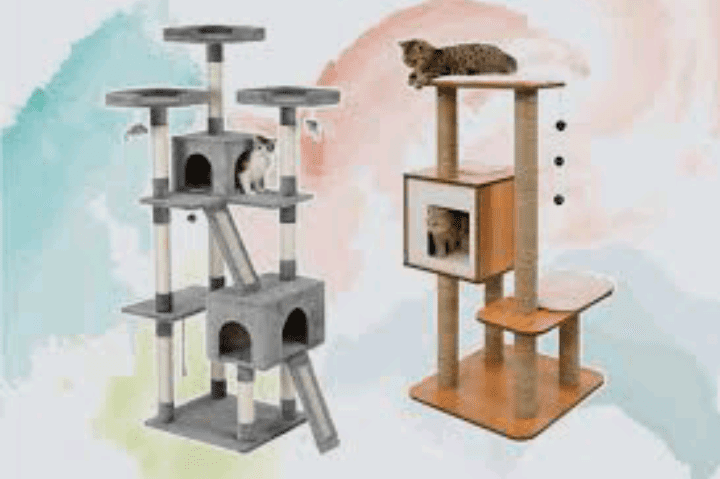Embarking on the adventure of building your very own DIY cat tree is more than just a weekend project – it’s an invitation for your feline friend to experience the epitome of comfort and playfulness right at home. In the world of pet ownership, few creations rival the charm and utility of a well-designed cat tree.
This article will guide you through the process of constructing a personalized haven for your cat, exploring the benefits, design considerations, and step-by-step instructions to ensure your furry companion has the perfect playground tailored to their preferences.
Picture this: a multi-tiered structure adorned with scratching posts, cozy perches, and secret hideaways. A DIY cat tree is not merely a piece of furniture; it’s a statement of love for your cat’s well-being and happiness. From the satisfying texture of sisal-covered posts for claw maintenance to plush perches providing a regal vantage point, every element is designed to cater to your cat’s instincts and desires.
In the upcoming sections, we’ll go into the reasons behind the popularity of DIY cat trees, exploring how these creations contribute to your cat’s physical health, mental stimulation, and overall satisfaction.
Additionally, we’ll guide you through the key considerations in crafting a cat tree that seamlessly integrates into your home while meeting your cat’s unique needs.
So, if you’ve ever wanted to elevate your cat’s living space to new heights – both literally and figuratively – join us as we uncover the secrets to constructing a DIY cat tree that will not only stand tall in your home but also in your feline companion’s heart.
Read also: DIY Raised Garden Bed: Your Gateway to Green Thumbs
DIY Cat Tree

The Benefits of a DIY Cat Tree
1. Enrichment and Exercise
Cats are natural climbers and explorers. A well-designed cat tree provides an opportunity for them to exercise their muscles, indulge their curiosity, and stimulate their minds. The various levels and platforms mimic the heights they would explore in the wild, promoting physical activity and mental engagement.
2. Territory and Vertical Space
Cats are territorial creatures, and vertical space is their domain. A cat tree not only offers them a place to perch and observe their surroundings but also creates additional territory in your home. This is particularly valuable in multi-pet households, where cats can establish their own space and reduce the likelihood of conflicts.
3. Scratching Outlet
Scratching is an innate behavior for cats, serving multiple purposes such as maintaining claw health, marking territory, and stretching muscles. A DIY cat tree, with strategically placed sisal-covered posts, provides an ideal scratching outlet, saving your furniture from the wear and tear of feline claws.
4. Comfort and Relaxation
Cats love to nap, and a cat tree with plush perches and cozy hideaways offers the perfect naptime retreat. Elevated spots provide a sense of security, allowing your feline companion to relax and survey their kingdom from a safe vantage point.
Design Considerations
1. Assessing Space and Placement
Before embarking on your DIY cat tree project, evaluate the available space in your home. Consider factors such as room size, traffic flow, and proximity to windows or other cat-friendly spots. Choose a location that allows your cat to feel integrated into the household while maintaining a sense of privacy.
2. Understanding Your Cat’s Preferences
Cats have individual preferences when it comes to climbing, scratching, and lounging. Observe your cat’s behavior to identify their favorite activities and locations. Some cats may prefer higher perches, while others may enjoy enclosed spaces. Tailoring your DIY cat tree to your cat’s preferences ensures it becomes a beloved fixture in their daily routine.
3. Materials and Safety
Choosing the right materials is crucial for the safety and durability of your DIY cat tree. Opt for sturdy, non-toxic materials such as plywood for the base and platforms, and sisal rope for scratching posts. Ensure all components are securely fastened, and avoid materials that may splinter or pose a choking hazard.
4. Incorporating Cat-friendly Elements
Enhance the appeal of your cat tree by incorporating elements that cater to feline instincts. Consider adding hanging toys, dangling ropes, or even incorporating catnip-infused elements to entice your cat. The more engaging and enjoyable the cat tree, the more likely it is to become a favored feline destination.
Read also: Creating Your DIY Fire Pit: A Guide to Cozy Outdoor Gatherings
Materials and Tools
1. Base and Platforms
Choose a sturdy base material such as plywood to provide stability. Cut the plywood into a size that fits your available space and accommodates your desired design. Sand the edges to prevent splinters.
2. Scratching Posts
Sisal rope is an excellent choice for scratching posts. Select wooden posts of varying heights, wrap them tightly with sisal rope, and secure the ends with adhesive. Ensure the posts are securely attached to the base for stability.
3. Perches and Hideaways
Create comfortable perches using plywood or repurpose wooden shelves. Attach carpet or faux fur to provide a cozy surface for lounging. For hideaways, consider incorporating enclosed spaces using plywood and soft fabric for added comfort.
4. Securing Hardware
Use appropriate hardware such as screws, brackets, and wood glue to secure all components. Reinforce connections to ensure the cat tree can withstand the dynamic movements and weight of your feline friend.
Step-by-Step Construction
Step 1: Planning
- Sketch a design that incorporates your cat’s preferences, including heights, scratching posts, perches, and hideaways.
- Create a list of materials and tools needed for construction.
Step 2: Base Construction
- Cut the plywood base to the desired size.
- Attach supporting beams or brackets for stability.
- Sand the edges to prevent splinters.
Step 3: Scratching Posts
- Select and cut wooden posts of varying heights.
- Wrap the posts tightly with sisal rope, securing the ends with adhesive.
- Attach the scratching posts to the base securely.
Step 4: Perches and Hideaways
- Cut plywood or repurpose wooden shelves for perches.
- Attach carpet or faux fur to create a comfortable surface.
- Create enclosed spaces using plywood and soft fabric for hideaways.
Step 5: Assembly
- Secure all components to the base using screws, brackets, and wood glue.
- Double-check the stability of the cat tree and make any necessary adjustments.
Step 6: Finishing Touches
- Add hanging toys, dangling ropes, or other cat-friendly elements.
- Sprinkle catnip on various surfaces to entice your cat to explore.
Read also: Environmental Management Tips for Businesses
